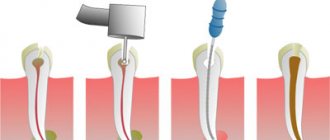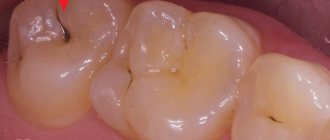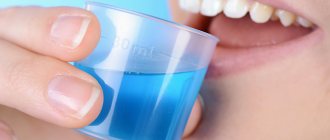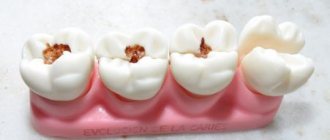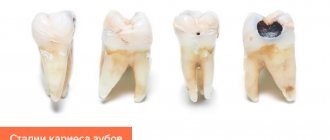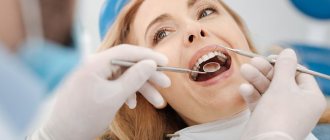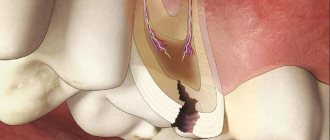In this article
- Early theories of caries development
- Modern approach to the study of caries theories
- Entin's neurotrophic theory
- Martin and Schatz theory
- Charpenak's theory
- Lukomsky's theory
- Entin's physicochemical theory
- Rybakov's concept
- Miller's theory
- Modern scientific theory of caries
- Conclusion
Although modern dentistry treats caries very effectively, scientists have not yet come to a consensus on the origin and causes of the development of this disease. There are different theories about the occurrence of dental caries, and we will talk about the most famous ones in this article.
Early theories of caries development
Scientists of ancient times were interested in why caries occurs, putting forward their own theories. For example, Hippocrates called the cause of the development of caries disease the mixing of bad “juices” of the human body and saw a direct connection between caries and diseases of the gastrointestinal tract and liver.
Scribonius Largus, a physician from Rome, was the author of the theory that dental disease was caused by microscopic worms invisible to the human eye. These worms, according to the Roman doctor, fed on dental tissues, as a result of which carious holes formed in them. As a therapy, he proposed using the steaming seeds of henbane, a poisonous plant from the nightshade family.
The worm theory of tooth decay remained popular for a long time. Initially, it was adhered to by the famous French dentist of the 18th century, Pierre Fauchard, who is considered one of the founders of modern dentistry. But, having examined the teeth under a powerful microscope, he realized that worms did not exist there, which means that the cause of dental caries lies in a different plane. He put forward his own theory, naming two reasons for the development of caries on teeth: diseased blood and lymph, as well as external influences.
Symptoms of the disease
Initially, the disease is practically asymptomatic. During this period, a barely noticeable white or brown spot appears on the tooth. This is the first sign of superficial destruction of the enamel, but its integrity has not yet been compromised. Later, a carious cavity appears at the site where the spots formed.
If unpleasant sensations appear during the process of eating, and at the end of the chewing process they disappear, this indicates the presence of a carious process. If the pain does not disappear after the end of exposure to the irritant (food, liquid), perhaps the first stage of caries has ended and pulpitis has begun.
In some cases, the onset of the disease may be indicated by an unpleasant odor from the mouth.
To establish an accurate diagnosis, you need to visit a dentist.
Modern approach to the study of caries theories
Today, all theories of the development of dental caries are usually divided into two large groups:
- Having only historical significance;
- They form the basis for scientifically based therapeutic and preventive measures.
The first group includes Entin’s neurotrophic and physicochemical theory of caries, Lukomsky’s trophic theory, Sharpenak’s metabolic theory and a number of others.
Miller's chemical-parasitic theory of caries was of utmost importance in the development of modern dentistry. Today, the main approaches to the prevention and treatment of teeth are based on Miller’s postulates. Let's take a closer look at the most famous theories of dental caries.
Martin and Schatz theory
According to the authors' conclusions, tooth enamel and dentin consist of mineral and protein components. Initial caries occurs as a result of the destructive action of bacterial enzymes on the protein part of tooth enamel. Further development of carious lesions is accompanied by demineralization of the enamel, which is affected by acid compounds with calcium ions. Since they easily dissolve in water, these compounds are washed out of the tooth enamel, and defects appear on it.
Part 1. Treatment of dental caries using modern instruments and filling materials
Currently, there are prerequisites for revising some provisions of practical cariesology. This is due to the fact that, on the one hand, views on the etiology of caries have been formed, new filling materials with fundamentally different properties have appeared, and the provision of dental institutions with equipment, instruments, and medications has improved. On the other hand, the requirements for the quality of dental care provided to the population have increased. The widespread use of paid treatment has increased the dentist's responsibility for the quality of his work and created a material interest in improving his professional level.
At the same time, it should be noted that, unfortunately, the issues of preparation of carious cavities, properties and methods of using modern materials in most textbooks, manuals and manuals are absent or clearly insufficiently covered.
The monograph by A.Zh. Petrikas, “Operative and Restorative Dentistry,” published in 1994 and recently republished, is intended primarily for doctors with practical experience. Some of its sections are difficult to understand for students just beginning to study dentistry. In addition, its circulation quickly sold out, and this book is not available in the libraries of universities and medical institutions.
In the textbook “Therapeutic Dentistry” edited by prof. E.V. Borovsky (1997) paid more attention to the issues of etiology, pathogenesis, and clinical picture of various dental diseases. The issues of treating dental caries are considered schematically, from a general clinical point of view. Only 20 pages are devoted to modern filling materials and methods of their clinical use.
“Atlas of the phantom course of therapeutic dentistry” (Magid E.A., Mukhin N.A., Maslyuk E.E., 1997) is distinguished by good printing, clarity, and in-depth coverage of a number of issues of the phantom course (embryology, anatomy, dental histology, jaw system, equipment and equipment of the dental office). At the same time, it does not clearly cover some issues of tactics and techniques for preparing carious cavities; modern filling materials, adhesive systems, and the technique of their clinical use are incompletely described.
Of great theoretical and practical interest is the monograph by I.M. Makeeva, published in 1997, “Restoration of teeth with light-cured composite materials,” however, it is intended primarily for doctors with experience working with composites, and is intended rather to improve practical skills and deepen theoretical knowledge, and not for a student audience.
The issues of etiology, clinical picture and prevention of dental caries are covered quite fully and competently in the monograph by L.M. Lukin “Dental Caries” (1999), however, the issues of dental materials science, techniques for preparing and filling carious cavities are reflected in it, in our opinion, in insufficient detail.
Journal articles, although they contain useful information, cover only certain issues of cariesology. These publications are fragmentary in nature and, as a rule, describe the materials of one particular manufacturer.
In the first part of the book, the authors sought to highlight modern approaches to the preparation and filling of carious cavities. The main emphasis is placed on the properties and methods of using filling materials, both traditional and new ones that have just appeared on the Russian dental market. Some readers may have a question: “Why is little attention paid to the etiological aspects of caries?” The answer can be this: this book is a practical guide for doctors and dental students; treatment methods are presented precisely on the basis of modern understanding of the etiology and pathogenesis of dental caries; the latter are fairly fully reflected in articles, monographs and textbooks published not so long ago.
We are aware that many of our recommendations, especially those related to the technique of preparing carious cavities, will not immediately be clearly accepted by dental therapists, so we are ready for a constructive discussion, since we believe that our main goals coincide - to improve the quality of dental care , raise the prestige of a specialist - a dentist.
CHAPTER 1. DENTAL CARIES
Dental caries is a complex, slowly developing and slowly flowing pathological process in the hard tissues of the tooth, resulting from the combined effects of unfavorable external and internal, general and local factors, characterized at the beginning of its development by focal demineralization of the inorganic part of the enamel, the destruction of its organic matrix and ending, as a rule, destruction of hard dental tissues with the formation of a defect (cavity) in the enamel and dentin, and in the absence of treatment - inflammatory complications from the pulp and periodontium.
1.1. Etiology and pathogenesis of caries
The problem of the etiology of dental caries is, in principle, recognized as solved by most researchers. It is believed that the cause of caries is the microflora of the oral cavity. The microbial (infectious) theory has been comprehensively and repeatedly proven both experimentally and clinically. Other theories and concepts rather reflect the significance of certain links in the pathogenesis of this disease.
According to modern views, caries occurs as a result of the pathogenic effect of microbial “dental” plaque on tooth enamel. Without dwelling on the structure and metabolism of this dental formation, we will only note the most important point - when eating easily digestible carbohydrate food, it is fermented by the microflora of the “dental” plaque with the formation of organic acids. In this case, the concentration of acids on the surface of the enamel increases tens of times and becomes sufficient to dissolve its inorganic base - hydroxyapatite crystals. Subsequently, microorganisms destroy the organic enamel matrix.
In general, for the occurrence and development of caries, three conditions are necessary:
1) the presence of cariogenic microflora;
2) intake of easily digestible carbohydrates from food and retention on the surface of tooth enamel;
3) reduction of caries resistance (resistance to the effects of cariogenic factors).
It seems to us that it is in individual caries resistance that one should look for the answer to the question: “Why does dental plaque form in all people, but caries does not always develop in them?” Apparently, when caries occurs, a threshold effect occurs, at which the intensity of the cariogenic effect of the “dental” plaque exceeds caries resistance.
Caries resistance refers to the resistance of the body and dental tissues to the occurrence of dental caries. V.K. Leontiev (1994) cites a large number of factors influencing resistance to caries.
At the molecular level, the resistance of teeth to acidic influences depends on the type of enamel hydroxyapatite, inclusions of microelements in the composition of hydroxyapatite, the presence of vacancies in the crystal structure, the degree of enamel mineralization, the correct formation and laying of the protein matrix, and the interaction of the protein and mineral components of the enamel.
At the tissue level (tooth enamel), resistance depends on the regularity of the enamel structure, the presence and number of defects in it, the nature of the formation of enamel fibers and bundles, especially when they come to the surface, and the mosaic nature of the electrical charge of the enamel, which prevents or promotes the adsorption of microorganisms on its surface.
At the level of the tooth as an organ, resistance to caries is determined by the structure of the enamel surface, the formation of a pellicle on it (an acquired thin organic film that replaced the nasmite shell), its interaction with the tooth surface, the depth and shape of dental fissures.
Fissures are folds of enamel between the masticatory cusps. They may be more or less deep. Depending on this, “open” and “closed” fissures are distinguished. An extreme variant of a closed fissure is a flask-shaped one (Fig. 4).
In “closed” and especially in flask-shaped fissures, extremely favorable conditions are created for the formation and existence of microbial “dental” plaque. It is these areas of the teeth that are the “favorite” places for the development of carious lesions.
At the systemic level (dentofacial system), resistance to dental caries depends on the type of structure of the facial skeleton, jaws, bite and tightness of the teeth, the size of the interdental spaces.
At the organismal level, resistance to caries depends on the functioning of the salivary glands, the degree of rinsing and cleansing of the tooth surface with saliva, the influence of immunological and antimicrobial factors in it, and a number of psychological aspects (chewing laziness, life characteristics).
As E.V. Borovsky and V.K. Leontiev (1991) rightly point out, “... almost each of the above factors depends on the general condition of the body, its reactivity and resistance.”
At the group and population level, dental resistance to caries depends on the process of reduction of the human dental system, the adverse effects of individual factors of civilization (diet, cooking, introduction of carbohydrates).
It should be noted that a number of the listed factors create a genetic predisposition to dental caries (the degree of severity of reduction of the dental system, the structure of the jaws, teeth, bite, composition and structure of their tissues).
It should be remembered that the above factors of caries resistance act not only in childhood, but also in adults.
It seems to us that it is taking into account individual caries resistance that not only preventive measures should be taken, but also a plan for sanitation of the oral cavity should be drawn up, tactics for carious cavity preparation and filling materials should be chosen, the timing of control examinations should be determined, and a guarantee for the quality of treatment should be given.
1.2. Classification of caries
The most widespread and recognized among dentists are currently the classification of carious cavities according to their location (Black) and the classification of caries depending on the depth of the lesion.
According to Black, the following classes of cavities are distinguished:
Class I. Cavities located in the pits and fissures on the chewing surface of molars and premolars, the lingual surface of the upper incisors, and in the vestibular and lingual grooves of the molars associated with the chewing surface.
Class II. Cavities on the contact (proximal) surfaces of molars and premolars.
Class III. Cavities on the contact (proximal) surfaces of incisors and canines that do not require removal and restoration of the cutting edge.
Class IV. Cavities on the contact surfaces of incisors and canines that require restoration of the cutting edge.
Class V. Cavities in the cervical region of all groups of teeth.
Currently, American dentists identify another class of carious cavities.
Class VI. Cavities on the cutting edge of the front teeth and on the tops of the cusps of the lateral teeth.
Topographic classification provides for four stages of caries (Fig. 5-8):
In our opinion, the classification that reflects the intensity of carious lesions (according to Nikiforuk, 1985) is also of practical interest, since it allows one to assess the severity of the lesion (“carious disease”) and outline an individual plan for treatment and preventive measures (Table 1).
Rice. 5-8. Caries in the spot stage. Superficial caries - focal demineralization, carious cavity of the enamel without the formation of a cavity within the enamel, Medium caries - carious, Deep caries - carious cavity within the enamel, cavity within the enamel and superficial layers of dentin and copulpar dentin
Table 1. Classification of caries according to the intensity of damage to the dental system (Nikiforuk, 1985)
| Severity of defeat | Affected teeth | Affected surfaces |
| Class I. Very weak caries | 17 | occlusal pits and fissures |
| Class II. Weak caries (ordinary caries) | 67 67 | occlusal fossae and fissures and occlusal |
| Class III. Average caries | 567 | occlusal and contact |
| 567 | ||
| Class IV. Severe caries (extensive caries) | 1234567 | proximal and occlusal and/or incidentally cervical 123567 |
| 4567 | ||
| 567 | ||
| Class V. Very severe caries (extremely common caries) | 1234567 | contact 1 2 3 and/or cervical 1234567 |
| 1234567 | ||
| 1234567 |
Charpenak's theory
An original study on the causes of dental caries was published in the 40s of the 20th century by Charpenak. In his work, he spoke about the existence of a chemical connection between the human body and the hard tissues of teeth. Therefore, the general condition of the body and how the external environment influences it are directly reflected in the teeth.
According to his theory, at the first stage, carious lesion is a dystrophic process that develops without the participation of bacteria. Its cause is metabolic disorders. And only in the second phase of the development of the disease, microorganisms penetrate into the dental tissues and continue to destroy enamel and dentin.
Story
The history of caries goes back to ancient times. At all stages of human development, dental diseases existed. This is evidenced by rock paintings in the Cro-Magnon cave, which are over 22,000 years old! Over time, caries became more and more aggressive. And this is largely due to changes in nutritional principles. People began to consume more sweets, and, as is known, a sweet environment is ideal for the proliferation of pathogenic bacteria that cause disease. Therefore, despite the development of dentistry, caries remains undefeated today. It is successfully treated, but it is impossible to completely protect yourself from the occurrence of this disease. However, a healthy diet, oral hygiene and a good lifestyle will increase your chances of having healthy teeth without knowing what they are.
Entin's physicochemical theory
Having studied the physicochemical properties of teeth and saliva, Entin decided that dental tissue is a partially permeable membrane that separates two environments - blood and saliva. When the normal pressure of these media on the septum is disrupted (due to an unbalanced diet, a weakened state of the body), problems arise with the nutrition of the enamel. As a result, tooth enamel is attacked by pathogenic microorganisms, contributing to the development of caries.
Clinical researches
Asept toothpastes are distinguished by their clinically proven effectiveness - the products have been repeatedly tested. As part of the tests, it was found that:
- regular use of preventive toothpaste ASEPTA ACTIVE for a month can reduce bleeding gums by 60%, improve the overall condition of the oral cavity by 44% and reduce inflammation by 33% (research);
- Regular use of preventive toothpaste ASEPTA SENSITIVE for a month can reduce bleeding gums by 62%, reduce sensitivity of teeth and gums by 48% and reduce inflammation by 66%. (study);
- regular use of professional toothpaste ASEPTA REMINERALIZATION after 4 weeks improved the condition of the enamel by 64% and reduced tooth sensitivity by 66% (study);
- Regular use of professional toothpaste ASEPTA GENTLE WHITENING for a month allows you to lighten tooth enamel by 1.5 tones, increases anti-caries effectiveness by 3.4 times and increases enamel remineralization by 2.6 times (research).
Sources:
- Report on determining/confirming the preventive properties of toothpaste “ASEPTA PLUS” GENTLE WHITENING” Author: doctor-researcher A.A. Leontyev, head Department of Preventive Dentistry, Doctor of Medical Sciences, Professor S.B. Ulitovsky First St. Petersburg State Medical University named after. acad. I.P. Pavlova, Department of Preventive Dentistry
- Clinical and laboratory assessment of the influence of domestic therapeutic and prophylactic toothpaste based on plant extracts on the condition of the oral cavity in patients with simple marginal gingivitis. Doctor of Medical Sciences, Professor Elovikova T.M.1, Candidate of Chemical Sciences, Associate Professor Ermishina E.Yu. 2, Doctor of Technical Sciences Associate Professor Belokonova N.A. 2 Department of Therapeutic Dentistry USMU1, Department of General Chemistry USMU2
- Report on the determination/confirmation of the preventive properties of personal oral hygiene products “ASEPTA PLUS” Remineralization doctor-researcher A.A. Leontyev, head Department of Preventive Dentistry, Doctor of Medical Sciences, Professor S.B. Ulitovsky First St. Petersburg State Medical University named after. acad. I.P. Pavlova, Department of Preventive Dentistry
- Clinical studies of antisensitive toothpaste “Asepta Sensitive” (A.A. Leontyev, O.V. Kalinina, S.B. Ulitovsky) A.A. LEONTIEV, dentist O.V. KALININA, dentist S.B. ULITOVSKY, Doctor of Medical Sciences, Prof. Department of Therapeutic Dentistry, St. Petersburg State Medical University named after. acad. I.P. Pavlova
- The role of anti-inflammatory rinse in the treatment of periodontal diseases (L.Yu. Orekhova, A.A. Leontyev, S.B. Ulitovsky) L.Yu. OREKHOVA, Doctor of Medical Sciences, Prof., Head of Department; A.A. LEONTIEV, dentist; S.B. ULITOVSKY, Doctor of Medical Sciences, Prof. Department of Therapeutic Dentistry of St. Petersburg State Medical University named after. acad. I. P. Pavlova
- Report on determining/confirming the preventive properties of toothpaste “ASEPTA PLUS” COFFEE and TOBACCO Author: doctor-researcher A.A. Leontyev, head Department of Preventive Dentistry, Doctor of Medical Sciences, Professor S.B. Ulitovsky. First St. Petersburg State Medical University named after. acad. I.P. Pavlova, Department of Preventive Dentistry
- Report on determining/confirming the preventive properties of commercially produced personal oral hygiene products: Asepta toothpaste used in combination with Asepta mouthwash and Asepta gum balm Head. Department of PFS Doctor of Medical Sciences Professor S.B. Ulitovsky St. Petersburg State Medical University named after Academician I.P. Pavlova. Faculty of Dentistry. Department of Preventive Dentistry.
Rybakov's concept
This scientist believed that the cause of dental disease was changes in the pulp - the loose connective tissue that fills the dental cavity. He assumed that the development of carious lesions begins from the inside and spreads from the center to the enamel of the tooth. According to Rybakov’s theory, at different periods of life a person is influenced by various factors that can cause carious tooth decay. In total, the author identified 6 age periods, and in each there were several factors contributing to the development of caries.
The above theories have a rational grain, but at the same time there are many controversial issues that do not fully explain all the nuances of the occurrence of caries. Therefore, it is impossible to create an effective system for the treatment and prevention of dental diseases based on one of them.
Disease prevention
First of all, you need to pay attention to your diet and provide yourself with enough vitamins. Regular brushing of your teeth will also reduce the likelihood of developing the disease. Use high-quality Asepta toothpastes. They contain the natural enzyme papain, which effectively breaks down plaque. And optimally selected minerals strengthen the enamel, which also prevents tooth decay. Healthy sleep, proper rest and lack of stress minimize the risk of caries.
It is necessary to undergo examination by a dentist twice a year to detect the disease at an early stage and treat it. Only an experienced specialist can make an accurate diagnosis and prescribe treatment.
If the disease is neglected, pulpitis may occur. As a result of tooth decay due to tooth decay, a person may suffer severe pain and eventually lose the tooth.
Miller's theory
Miller's chemical-parasitic theory succeeded in becoming the basis for the modern concept of caries treatment. The development of caries, according to Miller, is due to the complex influence of acids and microbes on teeth and occurs in two stages. First, microorganisms ferment carbohydrates, resulting in the formation of organic acids. Under their influence, hard tissues are destroyed and lose minerals. At the second stage, microbial damage to dentin occurs, and the tooth is destroyed even deeper. Along with the local damaging effect of microorganisms, in his work Miller took into account the important role of other factors in the development of caries. Among them are dietary features with a high content of carbohydrates, a lack of minerals, the quality and quantity of saliva, heredity, and social environment.
Although Miller's theory had, along with strengths, weaknesses, and caused a lot of discussion and controversy, it marked the beginning of a whole series of experimental and clinical studies. And many postulates of the modern concept are directly related to Miller’s theory.
Factors causing caries
Factors influencing the occurrence of the disease include:
- Sexual.
- Age.
- Professional.
- Social.
- Geographical.
Representatives of the fair sex experience caries more often than men. This is due to hormonal changes in their body during pregnancy and lactation. During the period of bearing a child, a woman's saliva composition changes, which leads to the development of the disease. In addition, according to statistics, women consume more sweets, which also negatively affects the condition of tooth enamel.
The age factor implies the development of the disease in people aged from eleven to forty years, and the professional factor is directly related to the person’s profession. The most dangerous industries include:
- The field of confectionery production.
- Production of alkalis and acids.
It is also believed that the disease occurs more often in those people whose activities are associated with stress and constant nervous tension.
The social factor refers to a person’s income level. With financial income, a person eats more expensive, healthy and high-quality food, and also has the opportunity to be regularly examined and treated by a dentist.
According to the geographical factor, the occurrence of the disease is influenced by:
- Minerals in water and soil.
- Climate.
- Amount of precipitation, etc.
Drinking water contains fluoride. If in the region in which a person lives, the amount of this microelement is higher than normal, this leads to fluorosis (the natural color of the teeth changes and defects appear on the enamel); if it is lower, a lack of fluoride provokes the appearance of caries.
Modern scientific theory of caries
Modern scientists (for example, E.V. Borovsky) believe that dental caries occurs due to the negative impact of several groups of factors:
- general (poor quality nutrition, water with low fluoride content, diseases and functional disorders of internal organs);
- local (microflora, deposits on the surface of the teeth, disturbed composition of saliva, residues of carbohydrate foods in the mouth);
- violations of the stability of dental tissues (incorrect chemical composition, hereditary predisposition to caries).
The interaction of different groups of factors creates a situation of increased risk of caries development.



